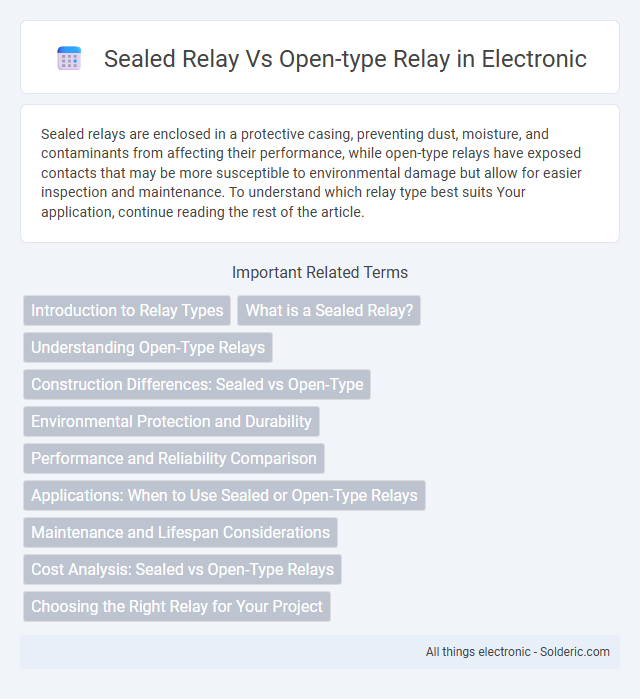Sealed relays are enclosed in a protective casing, preventing dust, moisture, and contaminants from affecting their performance, while open-type relays have exposed contacts that may be more susceptible to environmental damage but allow for easier inspection and maintenance. To understand which relay type best suits Your application, continue reading the rest of the article.
Comparison Table
| Feature | Sealed Relay | Open-Type Relay |
|---|---|---|
| Enclosure | Hermetically sealed, airtight | Exposed contacts, open shell |
| Durability | High, resistant to dust and moisture | Lower, prone to contamination |
| Maintenance | Minimal, no cleaning required | Requires regular inspection and cleaning |
| Lifespan | Longer due to protection | Shorter, affected by environmental factors |
| Applications | Critical, harsh environments, industrial | General use, controlled environments |
| Cost | Higher due to sealing and materials | Lower, simpler construction |
| Switching Speed | Typically slower due to encapsulation | Can be faster with direct contact |
Introduction to Relay Types
Sealed relays feature enclosed contacts that are protected from dust, moisture, and other contaminants, enhancing durability and reliability in harsh environments. Open-type relays expose their contacts to the environment, making them suitable for controlled settings where quick visual inspection and air circulation are needed. Your choice between sealed and open-type relays depends on the specific application requirements, including environmental conditions and maintenance preferences.
What is a Sealed Relay?
A sealed relay is an electromechanical switch enclosed in a protective, airtight casing that prevents dust, moisture, and contaminants from interfering with its internal contacts and moving parts. This design enhances reliability, longevity, and performance, especially in harsh or industrial environments where exposure to external elements is common. Choosing a sealed relay for your application ensures improved durability and consistent electrical switching under demanding conditions.
Understanding Open-Type Relays
Open-type relays feature exposed contacts and coils, allowing easy inspection and repair but increasing vulnerability to dust, moisture, and mechanical damage. These relays are often preferred in controlled environments where accessibility and maintenance are priorities. Their design enables quick troubleshooting but requires protective measures to ensure reliability in harsh conditions.
Construction Differences: Sealed vs Open-Type
Sealed relays feature an airtight enclosure that protects internal components from dust, moisture, and contaminants, ensuring enhanced durability and reliability in harsh environments. Open-type relays have exposed contacts and coils, making them more vulnerable to environmental factors but easier to inspect and maintain. The sealed construction often involves epoxy or resin encapsulation, while open-type relays rely on external housing for protection without complete isolation.
Environmental Protection and Durability
Sealed relays provide superior environmental protection by enclosing internal components within airtight housings, preventing dust, moisture, and contaminants from causing malfunctions. Open-type relays lack protective casings, making them susceptible to corrosion, dirt ingress, and mechanical wear, which reduces durability in harsh conditions. For applications demanding long-term reliability and resistance to environmental factors, sealed relays offer enhanced longevity and consistent performance.
Performance and Reliability Comparison
Sealed relays offer superior environmental protection by preventing dust, moisture, and contaminants from affecting internal contacts, enhancing long-term reliability and consistent performance under harsh conditions. Open-type relays, while generally easier to inspect and maintain, are more susceptible to corrosion, dirt accumulation, and mechanical wear, which can lead to performance degradation over time. Consequently, sealed relays are preferred in critical applications requiring high durability and stable operation, whereas open-type relays may suit less demanding environments where cost and accessibility are prioritized.
Applications: When to Use Sealed or Open-Type Relays
Sealed relays are ideal for applications requiring protection from dust, moisture, and contaminants, such as in automotive or outdoor equipment, ensuring long-term reliability and reduced maintenance. Open-type relays are better suited for controlled environments like industrial automation or laboratory settings where easy inspection and cooling are necessary. You should choose sealed relays for harsh environments and open-type relays for clean, ventilated spaces where accessibility is important.
Maintenance and Lifespan Considerations
Sealed relays offer superior protection against dust, moisture, and contaminants, significantly reducing maintenance requirements compared to open-type relays. Open-type relays require regular cleaning and inspection to prevent contact wear and corrosion, which can shorten their operational lifespan. Choosing a sealed relay can enhance your system's reliability and extend relay lifespan by minimizing environmental impact and maintenance needs.
Cost Analysis: Sealed vs Open-Type Relays
Sealed relays generally incur higher initial costs due to their protective casing, which enhances durability and prevents contamination, reducing maintenance expenses over time. Open-type relays offer a lower upfront price but may require frequent servicing and replacements caused by exposure to dust, moisture, and other environmental factors. Total cost of ownership for sealed relays often proves more economical in harsh or industrial settings where operational reliability is critical.
Choosing the Right Relay for Your Project
Selecting the right relay for your project depends on environmental factors and application requirements; sealed relays offer superior protection against dust, moisture, and contaminants due to their enclosed design, making them ideal for harsh or outdoor conditions. Open-type relays provide easier inspection and maintenance but are best suited for clean, controlled environments where exposure to debris or moisture is minimal. Consider factors like durability, reliability, and operating environment to ensure optimal performance and longevity of the relay in your specific application.
Sealed relay vs open-type relay Infographic

 solderic.com
solderic.com